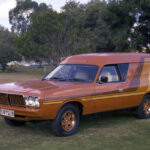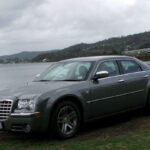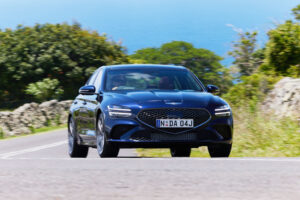
1935 Chrysler Airflow
After World War I the automobile soon became a dominant part of people’s lifestyles
and with its increasing importance the automobile itself was undergoing rapid change.
The 1930s began with flared mudguards, wide, vertical grilles and running boards but
by the end of the decade, mudguards began to merge integrally into the bodies of most
cars, and grilles began to narrow, while windscreens began to attain a backward slope
previously only seen on sportscars.
In 1934 when Chrysler introduced the Airflow it soon became known as one of the
ugliest cars on the road. Mechanically not a bad car, it was a horrendous looking thing,
with a blunt, downward sloping nose; an ungainly, top-heavy look; and an industrial-
style windshield did not help. The sweeping lines of the car flowed together in such a
way as to emphasise that its revolting aspect had actually been planned, making a bad
impression immeasurably worse.
Though it was dimensionally much like an average mid-sized car of the period, the
public quite understandably shied away from this monstrosity. While the design has
often been much touted as `ahead of its time’, it was ill-conceived _ a triumph of
engineering over style and appeal.
True, the Airflow was roomy and comfortable to drive, but the public could not
overcome their revulsion. The car design was a ground-breaking development which
exploited the use of wind tunnel technology. It had semi-unitary construction, and was
claimed to be more drag-efficient than any American automobile had ever been before.
In addition to the Chrysler Airflow a DeSoto Airflow was also produced. The DeSoto
was Chrysler’s companion line and it also shared Chrysler’s stylistic woes. A total sales
disaster, the Airflow design had been a major corporate mistake for Chrysler. Simply for
the sake of `keeping a stiff upper lip’, Chrysler Corporation continued production of the
DeSoto Airflow until 1936, while that of the marginally better-selling Chrysler Airflow
was dragged on to 1937.
As a means of trying to boost flagging sales Chrysler developed and offered for sale an
aftermarket attachable nose for fitting to Airflow models. This new nose design included
grille work and a redesigned bonnet which helped to improve the enormously sad-
looking headlights and grille work which many prospective buyers thought reminded
them of the face of an insect. This desperate effort, however, did little to stimulate
sales. In the 1930s Ford and General Motors had so flooded the market with their cars
that they had established their concepts as the norm. Chrysler’s revolutionary design
did not catch on at the time but in later years the low drag design was influential in
getting more designers to follow this lead.









